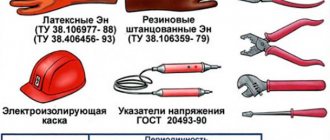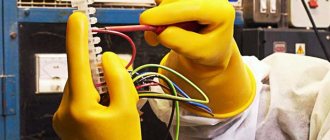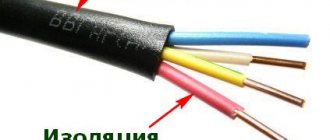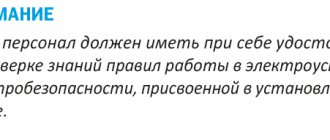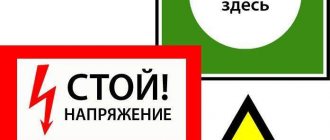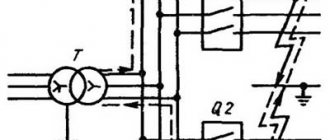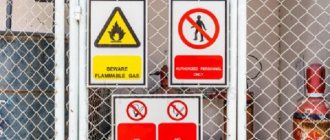When working with electrical devices, following safety rules is very important. One of the key points is the use of electrical protective equipment, which are items that protect a person from the effects of electric current. At the same time, it is important to know what insulating electrical protective equipment is used in electrical installations and what exactly they are intended for, as well as to monitor their condition, including timely inspection and replacement.
What types of electrical protection means there are and what are the testing times for electrical protective equipment will be discussed in this article.
Purpose of dielectric mats
Dielectric mats are considered an additional means of protection. If a worker works with live wires, it is likely that the current will pierce rubber gloves, boots or galoshes and other protective equipment. This is especially dangerous when the electrical appliance is not grounded. If work occurs in areas where humidity is high, this makes working with live devices even more dangerous. It is necessary to apply protective equipment comprehensively to guarantee the safety of the employee.
There are regulatory requirements that when working with voltages exceeding 1000 volts, the use of a mat and other methods of protection is mandatory.
Additional PPE
Scissors with insulating handles ND-1
Dielectric scissors are made with insulated handles made of material that does not transmit electric current. Scissors with protected handles are designed for cutting branches and branches of trees located near networks and electrical installations with voltage up to 1 kV. If necessary, the tool will be useful for removing wires that do not have a steel core. There are restrictive rings on the handles.
Test order
To determine the suitability of a tool for use, it is tested. An indicator of quality is the fact that the insulating parts of the dielectric scissors of this model can withstand a voltage of 2 kV for five minutes at an alternating current of 50 Hz.
During the test, voltage is applied to the metal part of the device and to the tube at the restrictive ring. If the device passes the test, a note about this is made in a special stamp on the insulation layer near the restrictive ring. The date of the next test is also indicated here.
Safety requirements
Since working with dielectric scissors is associated with danger, in addition to them, the worker must wear cash and safety glasses. If cutting branches or wires is carried out near electrical installations or power lines, additional electrical insulating agents should be used:
- rugs;
- bots;
- gloves.
The metal parts of the instrument must not be allowed to compress different phases or the phase-ground combination. It is prohibited to be in an area where cut branches or electrical wires are likely to fall.
Before use, scissors undergo a visual inspection. The integrity of the insulating coating is checked, the absence of moisture, traces of dirt and foreign substances that could impair the electrical protection of the tool. They also check the operation of mechanical parts, sharpening and smooth operation.
All pruning operations must be carried out in accordance with current rules, adopted instructions and other documents defining the procedure for carrying out work of this kind.
Passport details
- The weight of the dielectric scissors included is no more than 2.5 kg.
- The total length of the instrument is at least 0.65 meters.
- The length of the insulated part of the handles is at least 0.25 meters.
- The largest cross-section of an aluminum wire without a steel core allowed for cutting with scissors is 25 square millimeters.
- The maximum diameter of branches cut with scissors is 50 mm.
In addition to the tool, the delivery set includes a manual for its operation. Scissors with dielectric handles do not contain precious metals and can be disposed of as usual, as well as recycled.
Storage and transportation rules
Moving and storing scissors should take into account the specifics of the tool. The device can be transported by any type of transport in compliance with safety measures, as well as with full protection of the instrument itself from moisture, mechanical damage and contact with hazardous substances.
If the scissors need to be transported, their handles are tightly closed and securely fixed, the cutting parts are completely covered with thick fabric or cardboard for safety reasons.
Storage of scissors is carried out in accordance with the requirements of GOST 15150-69. As during transportation, in this case the instrument must be protected from exposure to caustic liquids, solvents, high humidity and other risk factors. During storage, the blades are treated with technical petroleum jelly or mineral oil. In this form, the instrument is wrapped in moisture-proof material.
manufacturer's warranty
Subject to the conditions of operation, transportation and storage, dielectric scissors are guaranteed to retain the qualities described by the manufacturer for 24 months.
Order of the Ministry of Emergency Situations of the Russian Federation dated December 31, 2002 N 630 On the approval and implementation of the Rules for labor protection in the units of the State Fire Service of the Ministry of Emergency Situations of Russia (POTRO-01-2002) (together with POTRO-01-2002...) (Registered with the Ministry of Justice of the Russian Federation 03.02. 2003 N 4176) The document is no longer valid 1HQQESHpv9LE
- Main menu ORDER
- RULES FOR OCCUPATIONAL SAFETY IN THE DIVISIONS OF THE STATE FIRE SERVICE OF THE MINISTRY OF THE RUSSIAN FEDERATION FOR CIVIL DEFENSE, EMERGENCIES AND ELIMINATION OF THE CONSEQUENCES OF NATURAL DISASTERS (POTRO-01-2002) I. General requirements
- II. Safety requirements when performing guard duty
- III. Security requirements during combat operations of units Call processing
- Departure and proceeding to the place of call (fire)
- Intelligence service
- Rescue of people and property
- Combat deployment
- Elimination of fire
- Carrying out special work in case of fire
- Collection and return to the unit
- Guardhouse
- Operation of fire equipment
- General responsibilities of the person responsible for labor safety on a fire-fighting ship
- Fire truck and motor pumps
Classification
It is customary to use the following types of rugs:
- Ordinary rug. It is characterized by a short service life and relatively low cost. It can be used at temperatures ranging from -15 to +40 degrees.
- Mid-range mats are made from higher quality rubber, which ensures a longer service life.
- A product that is resistant to chemically aggressive environments. Usually used in conjunction with a special stand. If the mat is used in aggressive conditions, its service life does not exceed 3000 hours.
Products usually have a fixed size. Depending on it, the price of the product is determined:
- The width ranges from 60 to 120 cm.
- The length can be different: from 50 cm to 8 m.
- In most cases, the thickness is 5-7 mm.
The price, depending on the size of the rug, is 100-500 rubles. Middle class rugs can be purchased for 3-5 thousand rubles. If oil and petrol resistant mats with stands are sold, their price can be 5 thousand rubles or more.
Also read: Instrument current transformer
If mats are used in aggressive environments, then special requirements are placed on them. The materials from which they are made are not subject to destructive effects. The stands are made of hard, inflexible material. Their thickness can be 7 cm or more. Typically, stands are made from bars spaced several centimeters apart.
Not only products of standard sizes can be used, but also those that are made to order. In this case, the shape of the mat can be made according to customer requirements.
Test periods for electrical protective equipment ensure safety when working with electrical appliances
When working with electrical devices, following safety rules is very important.
One of the key points is the use of electrical protective equipment, which are items that protect a person from the effects of electric current.
At the same time, it is important to know what insulating electrical protective equipment is used in electrical installations and what exactly they are intended for, as well as to monitor their condition, including timely inspection and replacement.
What types of electrical protection means there are and what are the testing times for electrical protective equipment will be discussed in this article.
Basic electrical protective equipment and their application
The safety of work carried out on electrical installations is ensured thanks to several groups of protective equipment.
What applies to electrical protective equipment:
- electrical protective equipment, the function of which is to prevent electric shock;
- means for collective and individual use, protecting against electromagnetic fields and used in installations with a voltage of at least 330 kV;
- individual protection means.
PPE is designed to prevent a person from falling, damaging the respiratory system, and injuring the face, head, and hands. This group also includes special suits that protect against electric arcs.
Individual, removable and portable shielding devices and portable grounding devices are used as protective objects against the action of electromagnetic fields. This also includes prohibitory, warning, and directional posters and signs.
What means are considered electrical protective and protect a person from the effects of current when working in electrical installations? This:
- insulating rods and pliers;
- voltage indicators;
- fixed and mobile devices and instruments indicating the presence of voltage;
- devices for safe measurements and testing;
- gloves, galoshes, rugs and stands made of materials with dielectric properties;
- shields or screens;
- caps, coverings and linings;
- individual tools with insulation (screwdrivers, pliers, etc.);
- ladders and stepladders made of non-conducting material;
- mobile grounding;
- posters and other warning, prohibition and directional signs.
All insulating electrical protective equipment, depending on the degree of protection, is divided into two subgroups.
Basic and additional electrical protective equipment
The classification of electrical protective equipment involves dividing them into basic and additional.
Basic electrical protective equipment includes those that provide a high degree of protection against electricity and allow you to touch and work on live parts.
It follows from this what insulating protective equipment is considered additional: they are used only in conjunction with the first category, since they cannot provide long-term and complete protection from electric current.
All funds are numbered and recorded and are periodically inspected and/or verified.
Depending on the voltage threshold that may exist in the electrical installation, both categories are divided into 2 sections.
List of electrical protective equipment:
| Basic insulating electrical protective equipment | Additional insulating electrical protective equipment |
| Electrical protective equipment in electrical installations up to 1000 V | |
| any insulating rods | galoshes and boots |
| insulation pliers | carpets and stands made of dielectrics |
| voltage presence and magnitude indicators | caps, coverings and linings insulating from current |
| electricity measuring clamp | ladders and stepladders |
| gloves made of dielectric material | |
| individual tool with non-conductive handles | |
| For installations with voltages above 1000 V | |
| capacitive and non-contact voltage indicators, for phasing | boots and gloves made of dielectric material |
| insulation pliers | carpets and coasters |
| insulating rods | ladders and stepladders |
| current measuring clamps | caps and covers for insulation |
| personal protective equipment | voltage alarms |
| protective devices for working under voltage |
Inspection and testing periods of dielectric protective equipment
An item used for electrical protection must have a special stamp indicating the following parameters:
- Name;
- manufacturer;
- date of manufacture;
- test period.
The last parameter is so important that if it is missing or the check expires, it is prohibited to use the tools in your work. The use of this electrical protection is a violation of safety regulations that carries a risk to life.
The first test of electrical protective equipment is carried out after production of the product, subsequent tests - after certain periods. The timing of testing electrical protective equipment is specified in GOST and TU.
The same documents stipulate the conditions and time of test work, as well as the frequency of inspections, which are usually carried out more often and can be either an independent diagnosis or a preliminary stage of verification.
The assessment of the mechanical and electrical qualities of protective equipment is usually carried out in specialized organizations.
Below is a table indicating the frequency of testing electrical protective equipment.
| Timing for testing dielectric protective equipment | Product type | Inspection frequency |
| Every six months | Dielectric gloves | Before each use |
| Ladders and stepladders | Semiannually | |
| Protective equipment for performing live repairs | ||
| Every year | Voltage indicators (up to 1 kV and above 1 kV with gas-discharge lamp and phasing) | |
| Insulating part of the cable piercing device | ||
| Insulating caps and coverings | ||
| Galoshes and boots made of dielectric material | ||
| Hand tools with handles made of insulating material | ||
| Once a quarter, but at least once a year | Measuring rod and its parts | Once a quarter |
| Every 2 years | Insulating rods | Every year |
| Insulating pliers | Every six months | |
| Current clamp | Semiannually | |
| Non-contact voltage indicators over 1 kV | Before use | |
| Insulating pads, hard and rubber | Once a year | |
| Every 3 years | Bots | Semiannually |
| Rubber caps |
Rugs and coasters are not tested, but they are subject to inspection once a year or once every 2 years, respectively. In general, a visual inspection of dielectric protective equipment, which includes mats, boots, galoshes, gloves, boots, is usually carried out before each use in order to detect a violation of the integrity of the coating.
If defects are revealed during inspection or testing, then insulating electrical protective equipment cannot be used.
2 Comments
Source: https://fufayka.net/siz/drugoe/sroki-ispytaniy.html
Requirements for rugs
The main function of such a product is electrical insulation between the worker’s feet and the floor. However, in order for the mat to perform its task. It must comply with the requirements of regulatory documents. To do this, the mats must have the following characteristics:
- It is necessary that the product can withstand a large number of bends without losing its properties.
- If the mat is stored in a warehouse, its characteristics must remain unchanged for 3 years. After this period, the mat must be changed even if it seems that no external changes have occurred.
- The surface of the mat on which a person stands must be corrugated. This is necessary to prevent slipping. In appearance, the structure of the product should look uniform.
- The presence of shells or bubbles on the grooved or smooth part is not allowed.
- The mat must withstand a voltage of 10 kV per 1 mm. In this case, the amount of leakage current must be limited.
- They are made from special rubber that has the necessary dielectric properties. The depth of the gaps when corrugating should be 1-3 mm.
- It is necessary that when bending in two perpendicular directions, even the smallest cracks cannot be seen at the fracture.
Rubber has the ability to change its physical characteristics over time. Therefore, you cannot rely on the reliability of an old rug. Such products become brittle and lose their ability to provide insulation from electric current.
Also read: KTPN - outdoor complete transformer substation
Tests
Before using them, you need to make sure that the mats have not lost their protective properties. To do this, it is necessary to carry out a check.
First you need to inspect the product. To make sure there are no cracks, you need to bend the mat several times. If stands are used, they should be inspected to show no chips or cracks.
If there are no mechanical damages, electrical breakdown tests are performed. For this purpose, the appropriate voltage is applied. Tests are carried out at a temperature of 15-40 degrees and a humidity of 45-75%.
If deficiencies are found, the products must be replaced. If the mats are in storage, they are checked every three years.
Fireman's dielectric kit and testing times
We all know what electricity is and of course you can’t joke with it, just like with fire. In our article we want to tell you about special protective equipment against the effects of electric current, or as they are also called dielectric means. Very often during fires there is a need to turn off the electrical voltage, as it can harm firefighters when performing work, but often it is not possible to turn off the voltage immediately and there is no time to wait for the emergency crew, because every minute counts. Now those same dielectric means come to the aid of firefighters. What do they include?
- dielectric gloves;
- dielectric boots;
- dielectric scissors;
- rubber mat.
Storage
Conditions of detention significantly affect the safety of products and their readiness for use. In order for rugs to be stored for a long time, the following rules must be followed:
- It is recommended to create suitable storage conditions. Suitable temperature is 20-25°C.
- If the rug was brought in from the cold, it is not recommended to use it immediately. It needs to be kept at room temperature for an hour.
- Do not store in close proximity to heating appliances.
- If the product becomes dirty after use, it must be cleaned. In this case, alcohol solutions cannot be used. As a result of use, the mat will harden.
- When using a mat, you need to make sure that there is no moisture on it. If this is not the case, you need to let it dry completely.
- If work takes place in cold rooms, the product intended for such conditions must be kept at room temperature for an hour. Otherwise, the insulating properties of the mat will be compromised, putting the worker's life in danger.
Products are stored in rolls or placed in packs. It is important that deformation does not occur during storage.
